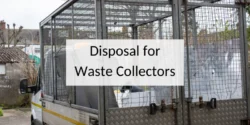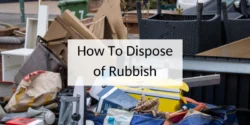Guide for Waste Disposal for Tradesmen and Handymen
A guide for tradespeople on how to dispose of bulky rubbish created at a customer’s property, including the 3 main disposal options, ways to save money, and key regulatory considerations.
Disposal options
Unless you are working for a large retail chain that includes waste removal as part of the customer’s overall package, you essentially have 3 options when it comes to disposing of works waste:
- Remove it yourself;
- Use a waste contractor to take it away; or
- Leave it with your customer to sort out themselves
Looking at each in turn…
1) Remove waste yourself
If you have an appropriate vehicle, can keep the waste away from dirtying your tools and equipment, and are insured and licensed as a waste carrier to move waste, then loading stuff on to your own vehicle and taking it away when you leave gives you the most flexibility.
If you take it straight to a tip, then you should consider not only the tipping cost but also the cost of your time spent doing this. This may amount to nothing if it’s the end of the day and on your way home – but can represent much more lost value if it is time when you could be doing more paid work.
At the tip, check what their minimum weight charge is. Most will charge you for 500kg (or 1000kg) of waste regardless of how light your load. So, if you only a little bit of rubbish, maybe save it up and come back another day.
On the other hand, if you take the waste back to a skip at your own premises rather than straight to the tip:
- ask your skip provider about having separate skips for different material (like wood, cardboard, metal, inert) which should work out cheaper;
- beware of creating an unlicensed transfer station. There is a difference between moving waste directly from your vehicle into a skip, and unloading waste on to the ground to breaking things down and sort and segregate. The latter is an unlicensed waste transfer station. Highly illegal, in breach of your planning consents, and not covered by your insurance in the event of a H&S accident or fire.
- Don’t burn stuff – although (sadly) it is completely legal for a householder to burn whatever they like in their garden if it doesn’t cause a public nuisance, businesses cannot.
2) Use a waste contractor
While it may seem cheap and efficient to remove the waste yourself, sometimes it pays to use a professional - leaving you more time to get on with growing your business or finishing off the work at hand and keeping your vehicle nice and clean inside.
There are 3 ways you can have your waste removed – 1) skip 2) skip bag 3) man & van. Which one you choose will depend on a host of reasons. The table below sets out some of the most obvious:
Table of Waste Disposal Methods
| Skip | Skip bag | Man & van | |
| Waste type
|
Good for lots of messy, dirty waste like rubble, tiles | Good for mainly messy, dirty waste like tiles | Can take any, but messy requires rubble bags |
| Size
|
6, 8 and 12 cu yards are most common. 4 yard rarely available | Most common are 1, 1.5 and 4.5 yards | Typical van size 12 or 14 yards. Charge less if less |
| Containment
|
Fixed container | Fixed (albeit floppy!) container | No containment. Protect grass using tarp or rubble bags |
| Cost
|
Cheapest if lots of heavy waste. Unless permit required | Most expensive per cubic yard | Cheapest unless lots of heavy waste |
| Speed
|
Rarely same day. Can be delated by need for skip permit | Rarely same day. Can be delated by need for skip permit | Normally fastest response |
| Labour
|
Not provided. Pay extra | Not provided. Pay extra | Labour included |
| Accessibility/ Space
|
Need space on site to place the skip | Needs to be placed | Waste can be picked up from anywhere |
| Length of project
|
Good for v long projects for neatness /H&S containment | Good for longer projects for neatness | Better for shorter term projects or frequent collections |
3) Leave it for your customer
From a customer service perspective, leaving the problem to your customer isn’t ideal. Arguably the least they can expect is that the people involved in charging them all this money, is to take away the rubbish they create. Nevertheless, assuming you’re not working on behalf of a retail brand that provides the waste removal anyway, sometimes it still may make sense for the customer to get rid of the junk rather than you.
For example, if your customer is having other works undertaken at the property around the same time, then getting a waste contractor to remove all of the waste combined in one go (or in one large skip) is likely to be cheaper in total than having two separate collections. And it may not just be other works. Your customer might want to take this opportunity to have a big clear out.
Equally, some customers just like being in control and doing their own research to make sure they aren’t overpaying. And those sorts of customers are probably best left to look after the waste disposal, because whatever you do – they’re almost bound to question whether it was the cheapest or most sustainable option.
Finally, if the customer engages the contractor directly, that will avoid the need for you to add an admin charge for putting it through your business.
Find the cheapest rubbish removal quotes
If you decide to use a man & van waste contractor, other than using LoveJunk to find your cheapest provider, we recommend the following tips to save yourself paying over the odds:
- Break the waste down to minimise the space it takes up – even though the weight will be the same, waste contractors have a fixed amount of space in their vehicle. So, if your waste takes up less space, that leaves them with more space to pick up other people’s junk before going to the tip.
- Bag loose waste – putting messy, loose waste like tiles, sawdust and rubble into rubble bags or bulk bags to stop it flying around, makes it easier for contractors to clear and load it onto their vehicle. Less time on site means more time to do other jobs
- Place waste close to the road – to reduce the loading time required for the waste collector. Less loading time, means a lower price.
- Is there anything the customer will take in their own bin? Be sensitive with how you do this, but particularly with small jobs, many customers are completely fine with you leaving waste nicely bagged in or beside their wheelie bin for collection by the council
- Leave appliances for the council or the scrap man – most councils will remove any household bulky appliance as part of their household bulky item collection service, and that service is often very cheap and sometimes even free. Equally, items like dishwasher and cooker have a scrap metal value. This means that licensed scrap metal merchants will often take them for free.
Regulation
1. Documentary record of the Waste Transfer
There is a legal requirement to record in writing when waste is transferred from one tradesperson to another and to keep that record for 2 years. This document is called a Waste Transfer Note. These days no particular document type is required. An invoice or works order is fine, provided it contains the following key info:
- Date, time and address of transfer
- Names, addresses and signatures of the parties and their roles (e.g. waste carrier vs waste producer)
- The SIC code of the person getting rid of the waste – n/a if it’s a householder
- Waste description - including the relevant European Waste Catalogue codes, the amount of the waste (kg or vol), manner of containment, and confirmation the person disposing of the waste has complied with their duty to apply the waste hierarchy (ie. basically considered and tried to reuse or recycle materials before disposing of)
The requirement for a waste transfer note does not apply when removing waste from a domestic property. So, if you fit a kitchen in someone’s home and then take the waste from that work away, strictly speaking you do not need to document it with a waste transfer note. That said, increasingly householders are concerned about where the waste is going and the disposal being properly documented, so it’s a good idea to provide one anyway as reassurance of your professionalism.
2. Waste carrier license
If you take waste away from a customer site (irrespective of whether you created it), you will need a waste carrier license from the Environment Agency (or SEPA if in Scotland). Rubbish removal without a license is illegal, with fines of up to £5,000.
There are 2 categories of waste carrier license – Lower Tier and Upper Tier. Upper tier is the most common and the one most installers/ fitters / builders require. It covers anyone removing other people’s waste and/or construction and demolition waste. C&D waste is defined as “typically including soil, concrete, bricks, glass, wood, plasterboard, asbestos, metal and plastic and …produced as part of a large construction project or a smaller business activity, like a general builder replacing a bathroom, or a gardener replacing fence panels and paving slabs”. FYI, Lower Tier is if you only move your own waste and that waste does not include any construction or demolition waste.
3. Insurance
As well as a waste carrier license, you will need van insurance that covers you for moving waste in your vehicle. Adding waste removal as a permitted activity will increase your premium, but not having it may be more costly in long run. Standard commercial vehicle insurance does not cover waste removal, so any accident when carrying waste in that vehicle, may well invalidate your insurance protection. Plus you could also be in breach of obligations owed to your larger commercial clients whose contractual terms require you to have valid insurance for what you do.
4. Temporary Storage – bringing waste back to your depot
If you take waste back to your own premises to be stored temporarily, so it can be collected later by a waste contractor or taken on for disposal elsewhere, this is covered by the Environment Agency temporary storage of waste exemption Non-Waste Framework Directive 3. To qualify the waste must
- be from work you carried out at a customer’s site (rather than their general waste)
- be stored securely
- not be particularly flammable and combustible
- not be unbonded asbestos,
- must be less than 50 cubic metres in volume.
Further reading:
- How to dispose of rubbish - our ultimate rubbish removal resource
- Rubbish removal prices comparison tool
- Skip hire guide
- Hippo Bag Guide






